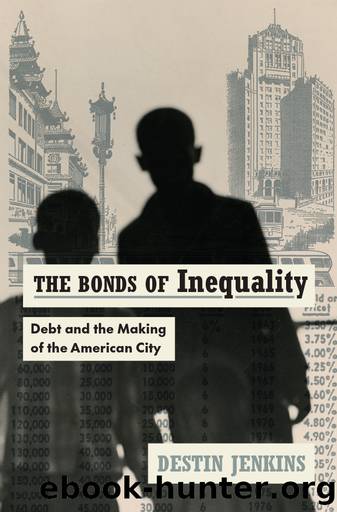The Bonds of Inequality by Destin Jenkins

Author:Destin Jenkins [Jenkins, Destin]
Language: eng
Format: epub
Tags: HIS000000 History / General, HIS036000 History / United States / General, BUS051000 Business & Economics / Public Finance, BUS036010 Business & Economics / Investments & Securities / Bonds, POL040040 Political Science / American Government / Local
Publisher: University of Chicago Press
Published: 2021-04-02T00:00:00+00:00
Clouded
It was easier to tinker with voter thresholds than it was to redress both the illicit infrastructural investment in whiteness and the rendering of black neighborhoods as unworthy of debt. By November 1969, the American Civil Liberties Union of Northern California contended that the two-thirds rule was a clear violation of the âone-man, one-voteâ mandate.95 In June 1970, the California Supreme Court agreed, ruling that future municipal bond issues needed only a simple majority to pass. In a provocative ruling, the court dismissed claims that the threshold preempted the âimmediate financial catastrophe and ultimate collapseâ of municipal governments. The predictions of âthe crushing burdens of debt foolishly incurred by reckless or malevolent popular majoritiesâ in fact obscured how the two-thirds rule gave greater voter power to ânoâ voters, effectively denying âyesâ voters an equal say.96 These doomsday scenarios were the language of bondholders. The California Supreme Court was not persuaded.
Yet with an appeal expected, a cloud still hung over Californiaâs municipal borrowers. In late July 1970, two major bond attorney firms, Orrick, Herrington, Rowley & Sutcliffe of San Francisco and OâMelveny & Myers of Los Angeles, questioned the ruling. âIn actual practice,â the Daily Bond Buyer (DBB) remarked, âapproval by either of the firms is essential before local government agencies can place their bonds on the market.â97 Without the backing of the municipal fraternity, future bond issues were dubious. As George Herrington explained, âno bond holder will take the risk.â98
The courtâs decision also âclouded the legality of local bond elections.â With an appeal headed to the US Supreme Court, Assemblyman John Knox of Contra Costa County presented a bill to affirm the California Supreme Courtâs ruling. He contended that borrowers could not wait either for the appeal to be heard or for a final decision. It was âimpossible for cities, counties and school districts to sell their bonds when approved by a simple majority.â99 Legal limbo threatened to upend the construction of hospitals, schools, parks, and street lighting, among other infrastructural fixtures.
With the hope that they could secure a simple majority, supporters returned in November 1970 with Proposition B, a $5.5 million bond to remedy the run-down, overcrowded schools in Hunters Point. They made the usual argument about savings for the city, minimal increases in the city's tax rate, and the costs of delay. They framed the issue in terms of equality of âmodern educational opportunitiesâ for all.100 The endorsement of the San Francisco Labor Council was about as familiar as Jeffrey J. Drapelâs racist, antipoor harangues against debt.
By the late 1960s, writes one historian, âwelfare had become firmly lodged in the California tax debate, not as a symbol of shared wealth assisting the needy, but as the embodiment of wasting taxpayer money.â101 Waste and extravagance were just as often racialized concepts backed by decontextualized numbers. It was true that San Franciscoâs welfare expenditures rose from $61 million in 1965â66 to $83.8 million in 1967â68.102 What people did with these facts and figures, though, was another matter. Drapel folded a racist critique of welfare into his opposition to the November 1970 bond measure.
Download
This site does not store any files on its server. We only index and link to content provided by other sites. Please contact the content providers to delete copyright contents if any and email us, we'll remove relevant links or contents immediately.
International Integration of the Brazilian Economy by Elias C. Grivoyannis(75118)
The Radium Girls by Kate Moore(11621)
Turbulence by E. J. Noyes(7702)
Nudge - Improving Decisions about Health, Wealth, and Happiness by Thaler Sunstein(7247)
The Black Swan by Nassim Nicholas Taleb(6770)
Rich Dad Poor Dad by Robert T. Kiyosaki(6182)
Pioneering Portfolio Management by David F. Swensen(6082)
Man-made Catastrophes and Risk Information Concealment by Dmitry Chernov & Didier Sornette(5652)
Zero to One by Peter Thiel(5494)
Secrecy World by Jake Bernstein(4389)
Millionaire: The Philanderer, Gambler, and Duelist Who Invented Modern Finance by Janet Gleeson(4101)
The Age of Surveillance Capitalism by Shoshana Zuboff(3990)
Skin in the Game by Nassim Nicholas Taleb(3971)
The Money Culture by Michael Lewis(3849)
Bullshit Jobs by David Graeber(3836)
Skin in the Game: Hidden Asymmetries in Daily Life by Nassim Nicholas Taleb(3726)
The Dhandho Investor by Mohnish Pabrai(3561)
The Wisdom of Finance by Mihir Desai(3526)
Blockchain Basics by Daniel Drescher(3331)
